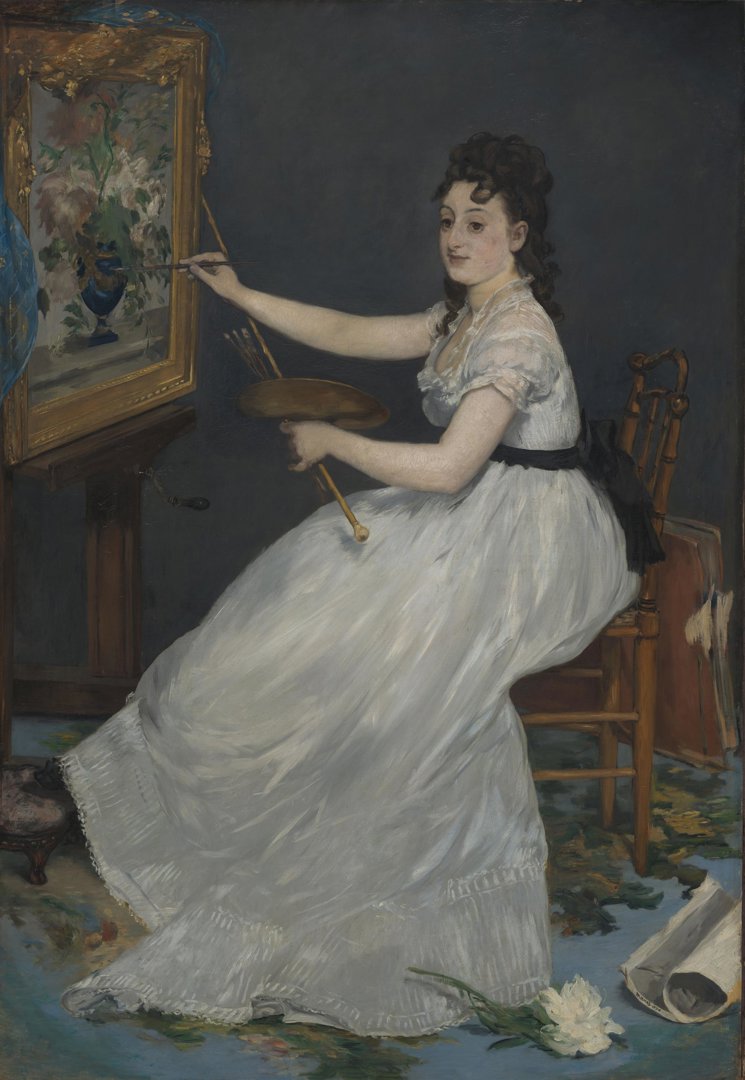Research reveals the many hidden faces of Eva Gonzales as new National Gallery exhibition announced
Issued January 2022
Hugh Lane Gallery, Dublin
1 June – 18 September 2022
The National Gallery
21 October 2022 – 15 January 2023
Sunley Room
Admission free
In 2022, the National Gallery will stage an exhibition Discover Manet and Eva Gonzalès devised around The Portrait of Eva Gonzalès (1870) by Édouard Manet (1832 –1883), the first UK exhibition devoted to Eva Gonzalès (1849–1883). The painting was acquired by Hugh Lane and considered by the early 20th-century as the most famous modern French painting in the UK and Ireland.
This will be the first in a new series of ‘Discover’ exhibitions in the Sunley room which aim to reveal well known paintings through a contemporary lens. The exhibitions will explore a single work from unexpected angles, shedding new light on prominent and beloved paintings from the collection. To begin the series, the exhibition takes Manet’s 'Portrait of Eva Gonzalès' as its focus, presenting a fresh perspective on women artists and their artistic practice. in 19th century Paris and more broadly.
The exhibition is organized with the Hugh Lane Gallery in Dublin and opens there before coming to London, celebrating the friendship and renewed spirit of cooperation between the two institutions following the new partnership agreed in 2021 regarding the 39 works in the Sir Hugh Lane Bequest*.
Though regarded as the father of modernism and a figurehead for the Impressionist generation, Manet only ever had one formal pupil, Eva Gonzalès. The daughter of a prominent writer, she entered Manet’s studio in 1869, at the age of 22. By the time of her death fourteen years later, following childbirth, she had become an established artist in her own right, her work regularly exhibited at the Salon.
An important section of the exhibition will present the findings of a new campaign of technical examination, indicating that Manet restarted the face dozens of times. The X-radiograph reveals parts of an earlier face that was rounder, with the curls on her forehead closer together. It also shows, for the first time, a little pot of brushes on the floor which was later painted over in alignment with Manet’s striving for simplification and clarity of design. X-ray fluorescence (XRF) tells us that Manet also reworked the dress, the chair, and the orientation of the easel. These findings confirm the account that fellow artist Berthe Morisot (1841-1895) gave of the portrait’s progress in a riveting series of letters to her sister. This provides insight into on Manet’s famously laborious process, in which scraping back and repainting was usual, but always disguised with spontaneous gesture and bravura handling.
'Portrait of Eva Gonzalès' becomes a gateway into women’s artistic practice and the representation and self-presentation of women artists in 19th-century Paris and more broadly. Self-portraits from the 18th to the 20th century will be brought together with depictions of women artists by men to explore different constructions of gender, status and talent. The exhibition will also provide a window into Manet and Gonzalès’s lifelong artistic dialogue, delving into the complex mixture of mentorship, admiration, and emulation that underpinned their friendship.
The free exhibition will include works by Eva Gonzalès, Elisabeth Louise Vigée Le Brun (1755-1842), Angelica Kauffmann (1741-1807), Berthe Morisot (1841-1895), Alfred Stevens (1823-1906), and Laura Knight (1877-1970), among others.
The Sunley Room exhibition programme is supported by the Bernard Sunley Foundation
Exhibition organised by the National Gallery and Hugh Lane Gallery
More information at nationalgallery.org.uk
Twitter @nationalgallery
Facebook @thenationalgallery
Instagram #nationalgallery
YouTube The National Gallery
Notes to editors
Image
Edouard Manet (1832–1883)
'Portrait of Eva Gonzalès' 1870
Oil on canvas
191.1 x 133.4 cm
Sir Hugh Lane Bequest, 1917, The National Gallery, London. In partnership with Hugh Lane Gallery, Dublin.
*The Sir Hugh Lane Bequest
In 2021, a new partnership was agreed between the National Gallery, London and the Hugh Lane Gallery, Dublin regarding the 39 paintings in the Sir Hugh Lane Bequest, which allows the public in both the UK and Ireland to continue enjoying these works on a regular basis.
In moving on from previous agreements made during the past 50 years, the two galleries are now committed to working in partnership regarding the care and display of these paintings in a spirit of collegiality. As part of the new 10-year partnership, the sharing and rotating of paintings will continue – however there will now be 10 paintings rotating in two groups of five, for five years in each location. Two works will remain in London. In the spirit of partnership, the works will now all be labelled ‘Sir Hugh Lane Bequest, 1917, The National Gallery, London. In partnership with the Hugh Lane Gallery, Dublin.’https://www.nationalgallery.org.uk/about-us/press-and-media/press-releases/new-partnership-agreed-between-the-national-gallery-and-hugh-lane-gallery
The National Gallery is one of the greatest art galleries in the world. Founded by Parliament in 1824, the Gallery houses the nation’s collection of paintings in the Western European tradition from the late 13th to the early 20th century. The collection includes works by Bellini, Cézanne, Degas, Leonardo, Monet, Raphael, Rembrandt, Renoir, Rubens, Titian, Turner, Van Dyck, Van Gogh and Velázquez. The Gallery’s key objectives are to enhance the collection, care for the collection and provide the best possible access to visitors. Admission free.
The Bernard Sunley Foundation
The Sunley Room was established at the National Gallery in 1984 and the Foundation has supported the exhibition programme in the Sunley Room every year since 1990. The Bernard Sunley Foundation is a family grant-making foundation which supports charities in England and Wales that deliver a real community focus and provide greater opportunities for the young, the elderly, the disabled and the disadvantaged.
For more information and images
For further information, please contact the National Gallery Press Office on 020 7747 2865 and email press@ng-london.org.uk
Publicity images can be obtained from https://press.nationalgallery.org.uk/

